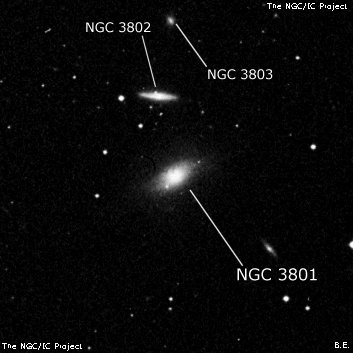
William Herschel discovered NGC 3801 = H III-30 = H II-161 = h939 on 14 Mar 1784 (sweep 170) and recorded III-30 as "vF, pS, r, preceded by two vB stars." His position is only 8 sec of RA following NGC 3801 = UGC 6635, although John Herschel (in the GC) and Dreyer (in the NGC) assumed it applied to NGC 3802, 2.3' north of NGC 3801. A month later, on 17 Apr 1784 (sweep 198), he returned to the field and recorded II-161 as "F, not S, R, bM." His position on this sweep is 4' too far south. John Herschel made 3 observations and his mean position matches UGC 6635.
Since WH observed only one object near this position on both sweep 170 and 198, we can assume he picked up the brighter galaxy NGC 3801 both times, and missed NGC 3802. In fact, he was uncertain if H. II-161 was new or identical to H. III-30, though decided to assign it a new internal number. So, H. II-161 = H. III-30 = NGC 3801 and JH should be credited with the discovery of NGC 3802. Wolfgang Steinicke confirmed these conclusions (email on 7/15/14).
400/500mm - 17.5" (4/1/95): brightest in a group. Fairly faint, fairly small, elongated 3:2 NW-SE, 1.2'x0.8', broad concentration to a brighter core. Forms a close pair with NGC 3802 2.3' NNE. Also in the field are NGC 3790 7.0' WSW and NGC 3806 8.1' NE. Located 7' WNW of mag 8.7 SAO 99729.
900/1200mm - 48" (4/2/11): the brightest of 6 galaxies in a 15' group that is stretched out in a SW to NE orientation. At 375x appeared very bright, very large, elongated 3:2 WNW-ESE, ~2.5'x1.7', sharply concentrated with a very bright core and much fainter outer halo. There is some ill-defined structure in the halo, either due to dust, spiral arms or both. NGC 3802 is 2.3' N, MCG +03-30-035 is 3.4' SW, NGC 3803 is 4.5' N, NGC 3790 is 7' WSW and NGC 3806 is 8' NE. MCG +03-30-035 (B = 16.6) appeared fairly faint, moderately large, very elongated 4:1 SW-NE, ~40"x10". A mag 11.5 star is 2.4' preceding.
Notes by Steve Gottlieb